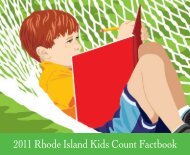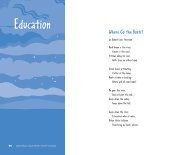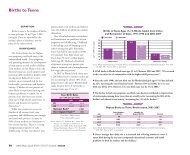2010 Rhode Island Kids Count Factbook
2010 Rhode Island Kids Count Factbook
2010 Rhode Island Kids Count Factbook
You also want an ePaper? Increase the reach of your titles
YUMPU automatically turns print PDFs into web optimized ePapers that Google loves.
Children Receiving SNAP Benefits<br />
75000<br />
65000<br />
DEFINITION<br />
Children receiving SNAP benefits<br />
(formerly the Food Stamp Program) is<br />
the number of children under age 18<br />
who participated in the Supplemental<br />
Nutrition Assistance Program (SNAP)<br />
in 2009 and the percentage change<br />
between 2005 and 2009 in the number<br />
of children under age 18 participating.<br />
SIGNIFICANCE<br />
Hunger and lack of regular access to<br />
sufficient food are linked to serious<br />
physical, psychological, emotional and<br />
academic problems in children and can<br />
interfere with their growth and<br />
development. 1,2,3 The Supplemental<br />
Nutrition Assistance Program (SNAP),<br />
formerly the Food Stamp Program,<br />
helps low-income individuals and<br />
families obtain better nutrition through<br />
monthly benefits they can use to<br />
purchase food at retail stores and some<br />
farmers’ markets. 4 Children who receive<br />
SNAP benefits are 26% less likely to go<br />
hungry than eligible children who are<br />
not enrolled. 5<br />
Traditionally, SNAP has been<br />
available to households with gross<br />
incomes below 130% of the federal<br />
poverty level, net incomes below 100%<br />
of the federal poverty level, and no<br />
more than $2,000 in resources. 6 In<br />
April 2009, <strong>Rhode</strong> <strong>Island</strong> implemented<br />
expanded categorical eligibility, an<br />
option encouraged by the U.S.<br />
Department of Agriculture (USDA),<br />
which allowed <strong>Rhode</strong> <strong>Island</strong> to increase<br />
the gross income limit and remove the<br />
resource limit for most applicants. 7,8<br />
The gross income limit for <strong>Rhode</strong><br />
<strong>Island</strong> is now 185% of the federal<br />
poverty level ($2,823 per month for a<br />
family of three in 2009). Households<br />
must still meet the net income limit<br />
of 100% of the federal poverty level<br />
after allowable deductions, which<br />
include deductions for housing costs<br />
and child care. 9,10<br />
Purchasing food using SNAP<br />
benefits helps many low-income<br />
families bridge the gap between what<br />
they earn and their basic living<br />
expenses. In 2008, a <strong>Rhode</strong> <strong>Island</strong><br />
family with one full-time, year-round<br />
worker making the minimum wage had<br />
only 70% of the income needed to<br />
meet basic expenses. If the same family<br />
received SNAP benefits, they would be<br />
able to meet 84% of their basic needs. 11<br />
In 2009, the average monthly SNAP<br />
benefit for a family of three in <strong>Rhode</strong><br />
<strong>Island</strong> was $388. 12<br />
SNAP is an important anti-hunger<br />
program that helps individuals and<br />
families purchase food when they have<br />
limited income, face unemployment or<br />
reduced work hours, or experience a<br />
crisis. SNAP is one of the fastest and<br />
most effective forms of economic<br />
stimulus because it moves money into<br />
the local economy quickly. 13<br />
5000<br />
45000<br />
35000<br />
Participation in the Supplementary Nutrition Assistance Program,<br />
Children and Adults, <strong>Rhode</strong> <strong>Island</strong>, 2000-2009<br />
75,000<br />
65,000<br />
55,000<br />
45,000<br />
35,000<br />
25,000<br />
Children<br />
37,519<br />
Adults<br />
2000 2001 2002 2003 2004 2005 2006 2007 2008<br />
Food Insecurity in <strong>Rhode</strong> <strong>Island</strong><br />
68,611<br />
41,468 53,220<br />
Source: <strong>Rhode</strong> <strong>Island</strong> Department of Human Services, In<strong>Rhode</strong>s Database, 2000 – 2009. Data represent children under<br />
age 18 and adults who participated in SNAP during the month of October.<br />
◆ The most recent USDA report estimates that in 2007 there were 50,000 <strong>Rhode</strong><br />
<strong>Island</strong>ers who were income-eligible for SNAP benefits but not enrolled. <strong>Rhode</strong> <strong>Island</strong><br />
ranked 40th (1st is best) in the U.S. for SNAP participation. 14<br />
◆ Since 2007, the number of <strong>Rhode</strong> <strong>Island</strong> children receiving SNAP benefits increased<br />
by 32%, from 40,224 in 2007 to 53,220 in 2009, while the number of participating<br />
adults increased by 59%, from 43,207 in 2007 to 68,611 in 2009. 15<br />
◆ The USDA defines food insecurity as not always having access to enough food for an<br />
active, healthy life. Between 2006 and 2008, 11.7% of <strong>Rhode</strong> <strong>Island</strong> households and 12.2%<br />
of United States households were food insecure. In 2008, more than one in every five<br />
(21.0%) U.S. households with children were food insecure, while one-half (50.3%) of<br />
U.S. households with children with incomes below the poverty level experienced food<br />
insecurity. 16<br />
◆ More than 50,000 <strong>Rhode</strong> <strong>Island</strong>ers receive emergency food assistance from food pantries<br />
and soup kitchens each month, and 41% of food pantry clients have children at home. In<br />
2009, over one-half (57%) of <strong>Rhode</strong> <strong>Island</strong>ers who accessed emergency food assistance also<br />
received SNAP benefits, up from 35% in 2006. 17<br />
2009<br />
44 <strong>2010</strong> <strong>Rhode</strong> <strong>Island</strong> KIDS COUNT <strong>Factbook</strong> / Economic Well-Being






